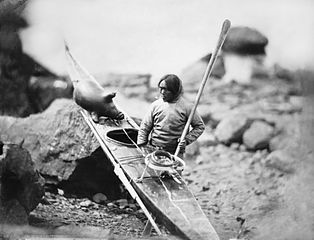The History of the Kayak
Aleut, Inuit, and Yup'ik peoples of the Arctic Circle and its fringe were crafting kayaks at least 4,000 to 5,000 years ago. "Kayak" comes from an Inuit word meaning "hunter's
 |
boat," and that's just what they were designed for. Natives hunted everything from seals and walrus to whales and caribou (targeted when swimming across rivers on migration routes) from kayaks, which offered fantastic speed, maneuverability, and security on rough, frigid waters.
Small design variations in traditional kayaks from Siberia to Greenland reflected both cultural and environmental factors, including the availability of building materials in a given region and the type of waters the boats were typically plying. The basic indigenous kayak had a frame fashioned from wood (often driftwood) or whalebone that was covered with sealskin waterproofed with fat or oil.
The fleet and highly maneuverable kayak used by the Aleuts, sometimes called the baidarka (Russian for "small boat"), was distinguished by its split prow, which may have increased both speed and stability as the bow cut through the waves.
Along with small, swift kayaks for hunting seals, caribou, and other medium-sized game, the Inuit and Yup'ik also built larger, wood-framed boats with open decks called umiaks. Often 30 feet or more long and steered by a number of paddlers, umiaks were essentially sea canoes used for hunting big quarry such as whales as well as for transporting people and goods.
Europeans adapted the native Arctic kayak for use in the burgeoning sport of whitewater running in the 1900s; early forms, such as the Klepper "foldboat," were made of a wooden skeleton and a canvas skin. The design eventually spread to North America. Beginning in the 1950s, kayaks crafted from synthetic materials--first fiberglass, then plastic and rubber--became widely available as the sport flourished and diversified.
